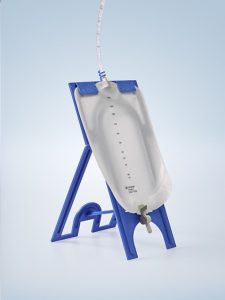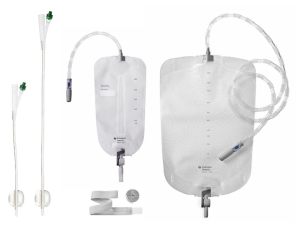Urology
Catheter Care
Patient Information Leaflet
This leaflet is designed to provide support and guidance to patients and carers about indwelling urinary catheters.
What is a urinary catheter?
A catheter is a hollow, flexible tube that is inserted into the urethra (waterpipe) to drain urine from the bladder. It can also be inserted into the abdominal wall (suprapubic) for the same reason.
It is kept in place by a balloon that is inflated with sterile water to prevent it falling out. The catheter is then connected either to a tap called a “valve” which will drain urine as and when needed.
Alternatively, the catheter connects to a bag which collects urine over several hours and is emptied when necessary.
A clinician will help decide which is the best option for you. It is usually made from silicone or latex so please make sure your nurse is aware of any allergies you are aware of.
Always consult a healthcare professional for advice before removing. We hope this leaflet helps you and if you have any concerns, please contact your local community nursing team.
Why are catheters used?
There are many reasons why people may need a catheter. You may be recovering from surgery, have difficulty emptying your bladder or may require medication inserted directly through the catheter. You should always be told why and how long it will be in for.
If you choose not to have a catheter when you are advised to, the risk of developing health problems increases such as bladder malfunction, bacterial infections and kidney failure as a result of a blockage. However, please be aware that having a urinary catheter also comes with risks.
What are the risks associated with having a catheter?
Haematuria (blood in urine)
It is quite common to see a small amount of blood within the catheter when it’s first inserted or with any vigorous activity. For example, if the catheter tugs on some clothing or if you accidentally fall over.
This is very common especially if you are taking blood-thinners. This should subside within a couple of days but if you become concerned, please call your local district nursing team or GP.
Pain
People with a catheter can occasionally experience cramping or bladder spasms which may be painful. This is natural reaction and we advise you take regular painkillers, then the pain should subside within a few days.
If you suffer on-going pain, please call your local district nursing team or GP.
Blockage
There are a range of reasons the catheter may become blocked. These are the steps to follow to try and resolve the issue;
- Check your catheter and tubing, release any kinks.
- Check the drainage bag is not too full.
- Movement can dislodge minor blockage, walking around may help.
- Medication can sometimes help relieve bladder spasm. Although it is not suitable for everyone this would need to be discussed with your doctor or nurse.
- Make sure your leg or night bag is positioned below the level of your bladder / waist to allow urine drainage.
If no urine drains from your catheter and you become uncomfortable you should contact the district nurse or out of hours service as it may need changing.
If urine is draining from your catheter but leaks around it, this is known as “bypassing”. Do not worry this is not a medical emergency, follow the previous advice mentioned in this document and it may resolve.
Contact the nursing team if it persists for more than a couple of days.
Infection
People with a urinary catheter have an increased risk of developing a urinary tract infection (UTI). UTI symptoms include stinging or burning in your bladder, abdominal or lower back pain, a raised temperature and feeling generally unwell.
Your urine may become cloudy, contain blood, or smell offensive. You may experience new or worsening confusion.
If you suspect you may have a urine infection, you should contact your GP or out of hours service. The best way of preventing infection is to drink plenty of fluids, especially water as described on page 4.
Caring for your catheter
Use correctly
- Urinary catheters with a bag or valve are secured to the leg or thigh using a ‘G-Strap’. Do not allow the bag to drag on the floor or hang from the urethra as this increases the risk of trauma and infection.
- At night, ensure the catheter bag or valve is connected to a night bag to collect urine overnight. Naturally, the kidneys will produce more urine at night, so a bigger bag is connected to the emptying port which allows you to get a good night sleep. You also have the option of a nightstand to hang the night bag on overnight to collect the urine securely and hygienically (as seen in the picture below).

Maintain good hygiene
- Wash and dry your hands before and after handling the catheter and drainage port.
- Wash the catheter entrance site with plain non perfumed soap and water once-twice daily. This decreases the risk of the skins natural bacteria and bodily fluids building up and reaching the catheter which may lead to a urine infection. For males, the foreskin will need to be pulled back for the catheter to be cleaned properly but ensure it is put back in place afterward to prevent it becoming trapped. If this happens, it is a medical emergency and should seek immediate help.
- Avoid using talc or creams around the catheter. Consult a professional if skin irritation is occurring.
- You can bathe or shower with the catheter in place as you wish although showers are advisable to decrease the risk of infection. Just make sure you empty the urine bag first.
- For supra pubic catheters (SPC), initially you may need to wear a dressing around the incision site, usually for the first 24 – 48 hours, however once healed this is not necessary and should be cleaned daily with mild soap and water.
- If you are wearing a valve, this must be cleaned daily as described above and changed every 5-7 days. Catheter legs bags must be changed every 7 days whilst a fresh night bag must be used daily. Always wash your hands before and after handling the bags and dispose of the materials safely within general household waste.
Increase your fluid intake
Unless told otherwise by your nurse or doctor, aim to drink 1.5 – 2 litres (3 pints) of fluid a day in order to prevent infection and help avoid constipation. Becoming constipated puts pressure on the bladder and increases the risk of bladder issues.
Take a bottle of water with you when you leave the house and keep a cup of water by your bed at night so that you can have a drink if you wake. Avoid caffeine drinks such as carbonated drinks, coffee or tea as this may irritate your bladder.
If you notice your urine is dark in colour, this indicates you may be dehydrated and need to increase your fluid intake to prevent you becoming ill.
All the hospitals urinary catheter products are supplied by a company called Bullen. The hospital will supply you with a “Bullen Bag” which contains all the products needed for 1 week.
If you require the catheter for longer than 1 week, Bullen will then contact you to arrange the next delivery of supplies and are also another point of contact for specialist advice and product selection.

The hospital should supply you with a spare catheter tube in case it requires changing at any time.
Images were kindly supplied by Coloplast Ltd and are Copyright to Coloplast A/S
Removal of the Catheter
Urinary catheters can last a varied amount of time, usually between 2-12 weeks depending on the reason it is put in. Your clinician will inform you of when it will be removed and will arrange for this to be done either in a clinic or by the community nurses. This is called a TWOC (Trial without catheter).
Do not try and remove it yourself. Some patients may have difficulty passing urine naturally after the catheter is removed for many reasons. A clinician will determine if whether the catheter needs to be replaced or if an alternative option is suitable such as intermittent self-catheterisation.
If you have any questions, or if there is anything you do not understand, please contact the Russells Hall Hospital switchboard number on 01384 456111 and ask for the relevant department who issued this leaflet.
If you have any feedback on this patient information leaflet please email dgft.patient.information@nhs.net
This leaflet can be made available in large print, audio version and in other languages, please call 0800 073 0510.
Originator: Gemma Bate. Date originated: July 2024 . Review date: April 2027. Version: 1 . DGH ref.: DGH/PIL/02206
